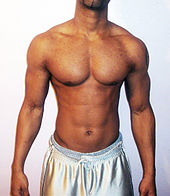How To Get In Shape For Summer
General shape of a human body

Human body shape is a complex phenomenon with sophisticated detail and function. The general shape or figure of a person is defined mainly by the molding of skeletal structures, as well as the distribution of muscles and fat.[1] Skeletal structure grows and changes only up to the point at which a human reaches adulthood and remains essentially the same for the rest of their life. Growth is usually completed between the ages of 13 and 18, at which time the epiphyseal plates of long bones close, allowing no further growth (see Human skeleton).[2]
Many aspects of body shape vary with gender and especially female body shape has a complicated cultural history. The science of measuring and assessing body shape is called anthropometry.
Physiology [edit]
During puberty, differentiation of the male and female body occurs for the purposes of reproduction. In adult humans, muscle mass may change due to exercise, and fat distribution may change due to hormone fluctuations. Inherited genes play a large part in the development of body shape.
Facial features [edit]


Classical male and female faces
Due to the action of testosterone, males may develop these facial-bone features during puberty:
- A more prominent brow bone (bone across the centre of the forehead from around the middle of eyebrow across to the middle of the other) and a larger nose bone.[3]
- A heavier jaw.
- A wider face.[4]
- More prominent chin.
Because females have around 1/4 the amount of testosterone of a male, the testosterone-dependent features do not develop to the same extent.
Skeletal structure [edit]


Comparison between a male (left) and a female pelvis (right). Females generally have wider hips relative to males in the same population. (Images not to scale.)
Skeletal structure frames the overall shape of the body and does not alter much after maturity. Males are, on average, taller, but body shape may be analyzed after normalizing with respect to height.The length of each bone is constant, but the joint angle will change as the bone moves.[5]
Female traits [edit]
Widening of the hip bones occurs as part of the female pubertal process,[6] and estrogens (the predominant sex hormones in females) cause a widening of the pelvis as a part of sexual differentiation. Hence females generally have wider hips, permitting childbirth. Because the female pelvis is flatter, more rounded and proportionally larger, the head of the fetus may pass during childbirth.[7] The sacrum in females is shorter and wider, and also directed more toward the rear (see image).[8] This sometimes affects their walking style, resulting in hip sway.[9] The upper limb in females have an outward angulation (carrying angle) at elbow level to accommodate the wider pelvis. After puberty, hips are generally wider than shoulders. However, not all females adhere to this stereotypical pattern of secondary sex characteristics.[10] Both male and female hormones are present in the human body, and though only one of them is predominant in an adult, the other hormone has effects on body shape to some extent.
Male traits [edit]

An adult man with a "V-shaped body"; pronounced shoulder width and expanded chest, both traits typically associated with male physique
Widening of the shoulders occurs as part of the male pubertal process.[6] Expansion of the ribcage is caused by the effects of testosterone during puberty.[ citation needed ]
Fat distribution, muscles and tissues [edit]

The rear view of a naked adult woman with pronounced hip width and large buttocks, both typically associated with female physique
Body shape is affected by body fat distribution, which is correlated to current levels of sex hormones.[11] Muscles and fat distribution may change from time to time, unlike bone structure, depending on food habits, exercises and hormone levels.
Fat distribution [edit]
Estrogen causes fat to be stored in the buttocks, thighs, and hips in females.[12] When females reach menopause and the estrogen produced by ovaries declines, fat migrates from their buttocks, hips and thighs to their waists.[13] Later fat is stored in the belly, similar to men.[14] Thus females generally have relatively narrow waists and large buttocks, and this along with wide hips make for a wider hip section and a lower waist-hip ratio compared to men.[15] Hormonal and genetic factors may produce male-like distribution of fat in women i.e. around the belly instead of buttocks and thighs.
Estrogen increases fat storage in the body, which results in more fat stored in the female body.[16] Body fat percentage recommendations are higher for females, as this may serve as an energy reserve for pregnancy. Males have less subcutaneous fat in their faces due to the effects of testosterone; testosterone also reduces fat by aiding fast metabolism. Males generally deposit fat around waists and abdomens (producing an "apple shape") due to the lack of estrogen.
Muscles [edit]
Testosterone helps build and maintain muscles through exercise. On average, men have around 10 times more testosterone than women. Prominent muscles of the body include the latissimus dorsi, trapezius, pectoral muscles (muscles critical for a strong erect posture) as well as biceps and triceps in the arms and quadriceps and hamstrings in the thighs.[ citation needed ]
Breasts [edit]
Females have enlarged breasts due to functional mammary glands, which develop from puberty onward due to the effects of estrogen. Mammary glands do not contain muscle tissue. The shape of female breasts is affected by age, genetic factors, and body weight.
Weight [edit]
Being overweight or underweight causes change in the human body's shape as well as posture and walking style. This is measured using Body Mass Index (BMI) or waist circumference. Depending on the BMI, a body may be referred to as slim, overweight, or obese.
Dieting, in conjunction with exercise, may be used to bring and keep the BMI within a healthy or desired range.[17] A person can calculate BMI, that is body mass index, to check that where you lie in terms of weight and height. A BMI between 18.5 and 24.9 is ideal. A person with a BMI below 18.5 is classed as underweight, above 24.9 is overweight and a BMI of 30 or higher is defined as Obese. [18]
The fats and carbohydrates in food constitute the majority of energy used by the body. They are measured cumulatively in the USA and many other places in calories and in kilojoules in some other parts of the world.
Body posture and gait [edit]
Body shape has effects on body posture[19] and gait, and has a major role in physical attraction. This is because a body's shape implies an individual's hormone levels during puberty, which implies fertility, and it also indicates current levels of sex hormones.[11] A pleasing shape also implies good health and fitness of the body. Posture also affects body shape as different postures significantly alter body measurements, which thus can alter a body's shape.[20] [21]
Impact on health [edit]
According to the Heart and Stroke Foundation of Canada, those people with a larger waist (apple shaped) have higher health risks than those who carry excess weight on the hips and thighs (pear shaped). People with apple shaped bodies who carry excess weight are at greater risk of high blood pressure, Type 2 diabetes and high cholesterol.[22]
Fitness and exercise [edit]
Different forms of exercises are practiced for the fitness of the body and also for health. It is a common belief that targeted exercise reduces fat in specific parts of the body —for example, that exercising muscles around the belly reduces fat in the belly. This, however, is now proven to be a misconception; these exercises may change body shape by improving muscle tone but any fat reduction is not specific to the locale. Spot reduction exercises are not useful unless you plan proper exercise regime to lose overall calories. But exercising reduces fat throughout the body, and where fat is stored depends on hormones. Liposuction is surgery commonly used in developed societies to remove fat from the body.
Social and cultural ideals [edit]

The general body shapes of female and male bodies both have significant social and cultural symbolism. Physical attractiveness is closely associated with traits that are considered typical of either sex. The body mass index (BMI), waist-to-hip ratio, and especially waist-to-chest ratio in men have been shown in studies to rank as overall more desirable to women. To be deemed to have an "athletic built"/build[23] is usually a reference to wide shoulders, a muscular upper body and well-developed upper-arm muscles which are all traits closely associated with masculinity, similarly to other specifics of the male sex, like beards. These traits are seen more sexually attractive to women and also associated with higher intelligence, good leadership qualities and better health.[24]
Terminology [edit]
Classifications of female body sizes are mainly based on the circumference of the bust-waist-hip (BWH), as in 36–24–36 (inches) respectively. In this case, the waist-hip ratio is 24/36 = 0.67. Many terms or classifications are used to describe body shape types:
- V shape: Males tend to have proportionally smaller buttocks, bigger chests and wider shoulders, wider latissimus dorsi and a small waist which makes for a V-shape of the torso.
- Hourglass shape: The female body is significantly narrower in the waist both in front view and profile view. The waist is narrower than the chest region due to the breasts, and narrower than the hip region due to the width of the buttocks, which results in an hourglass shape.
- Apple: The stomach region is wider than the hip section, mainly in males.
- Pear or spoon or bell: The hip section is wider than the upper body, mainly in females.[25]
- Rectangle or straight or banana: The hip, waist, and shoulder sections are relatively similar.
See also [edit]
- Body image – Person's perception of the aesthetics or sexual attractiveness of their own body
- Body proportions – proportions of the human body in art
- Dad bod – A slang term for a body shape particular to middle-aged men
- Female body shape – Cumulative product of the human female skeletal structure and distribution of muscle and fat
- Human gait – a pattern of limb movements made during locomotion.
- Human physical appearance – Look, outward phenotype
- Phenotype – Composite of the organism's observable characteristics or traits
- List of human positions – Physical configurations of the human body
- Human skeleton – Internal framework of the human body
- Male body shape
- Sex differences in humans – Difference between males and females
- Sexual dimorphism – The condition where males and females exhibit different characteristics
- Somatotype and constitutional psychology – Taxonomy to categorize human physiques
- Eugenics – Set of beliefs and practices that aim to improve the genetic quality of a human population
References [edit]
- ^ "Body shape is determined by the nature of body fat distribution". Archived from the original on 2007-07-05. Retrieved 2011-10-09 .
- ^ "Lateral Synovial Joint Loading Explained In Simple English". Archived from the original on 2021-01-26. Retrieved 2021-01-31 .
- ^ "Archived copy". Archived from the original on 2007-11-30. Retrieved 2007-06-18 . CS1 maint: archived copy as title (link)
- ^ Holden, Constance (August 20, 2008). "The Face of Aggression". Science. Retrieved 15 January 2021.
- ^ Saeki, Takatoshi; Furukawa, Takao; Shimizu, Yoshio (1997). "Dynamic clothing simulation based on skeletal motion of the human body". International Journal of Clothing Science and Technology. 9 (3): 256–263. doi:10.1108/09556229710168414. ISSN 0955-6222.
- ^ a b "Secondary sexual characteristics occur as part of the pubertal process". Retrieved 2011-10-09 .
- ^ See Gender differences in Human skeleton and Sexual dimorphism in Hips
- ^ Saukko P, Knight B. Knight's Forensic Pathology, 3rd Ed. Edward Arnold Ltd. 2004. ISBN 0-340-76044-3.
- ^ "Females walk with hip sway". Retrieved 2011-10-09 .
- ^ "Hips grow wider than their shoulders". Archived from the original on 2011-09-27. Retrieved 2011-10-09 .
- ^ a b "An Evolutionary Theory of Female Physical Attractiveness - Psi Chi". Archived from the original on 2007-07-05.
- ^ "Waistline Worries: Turning Apples Back Into Pears". Archived from the original on 2009-06-09.
- ^ "Women's Health". Retrieved 5 September 2015.
- ^ "Abdominal fat and what to do about it". Archived from the original on 2011-09-28. Retrieved 2007-06-18 .
- ^ "Why men store fat in bellies, women on hips". The Times of India. 2011-01-03. Archived from the original on 2012-01-14. Retrieved 2011-10-09 .
- ^ "Sex hormone making women fat?". The Times of India. 2009-04-07. Archived from the original on 2011-08-11. Retrieved 2011-10-09 .
- ^ "6 Proven Strategies to Get Rid of Fat and Get Healthier". 2017-01-29. Retrieved 2017-01-30 .
- ^ "9 best weight gain tips". 2020-06-04. Retrieved 2020-06-04 .
- ^ Gill, Simeon; Parker, Christopher J. (2017). "Scan posture definition and hip girth measurement: the impact on clothing design and body scanning". Ergonomics. 60 (8): 1123–1136. doi:10.1080/00140139.2016.1251621. PMID 27764997. S2CID 23758581.
- ^ Gill, Simeon; Parker, Christopher J. (2017-08-03). "Scan posture definition and hip girth measurement: the impact on clothing design and body scanning". Ergonomics. 60 (8): 1123–1136. doi:10.1080/00140139.2016.1251621. ISSN 0014-0139.
- ^ Parker, Christopher J.; Hayes, Steven George; Brownbridge, Kathryn; Gill, Simeon (2021-04-12). "Assessing the female figure identification technique's reliability as a body shape classification system". Ergonomics: 1–17. doi:10.1080/00140139.2021.1902572. ISSN 0014-0139.
- ^ "Assess your weight". Heart and Stroke Foundation of Canada. Archived from the original on 2011-08-25. Retrieved 2011-10-09 .
- ^ Williams, L.A. Resurfaced. ISBN9781105713033 . Retrieved 13 June 2020.
...and athletic built
- ^ Viren Swami, "The Influence of Body Weight and Shape in Determining Female and Male Physical Attractiveness" in Marlene V. Kindes (2006, editor), Body Image: New Research. Nova Publishers, New York. ISBN 1600210597; pp. 36—51
- ^ "Illustration of shape in body shape calculator". Retrieved 2011-10-09 .
External links [edit]
- Reproductive Anatomy and Physiology
- Clues to Mysteries Of Physical Attractiveness Revealed
How To Get In Shape For Summer
Source: https://en.wikipedia.org/wiki/Body_shape
Posted by: clarkducin1938.blogspot.com

0 Response to "How To Get In Shape For Summer"
Post a Comment